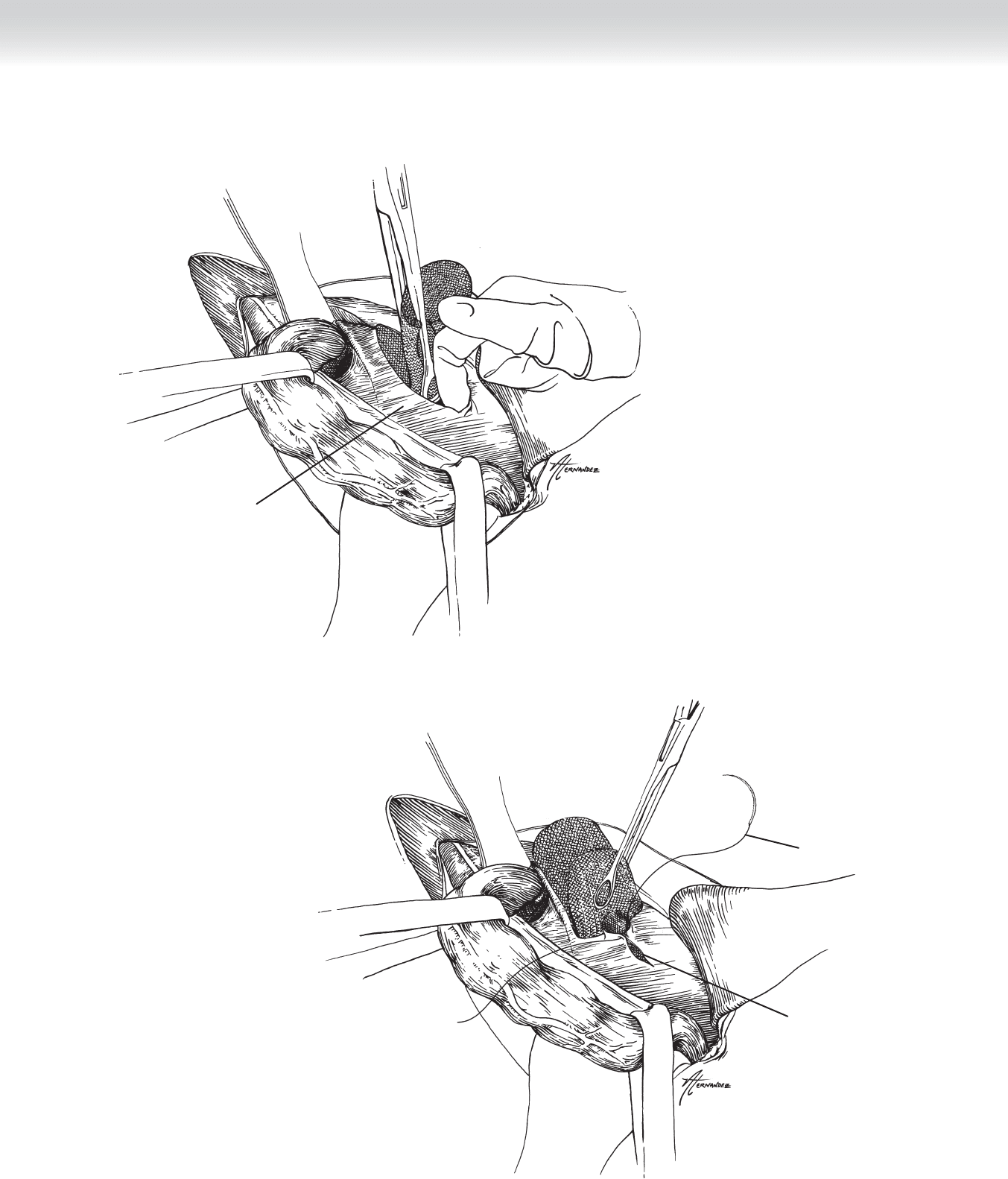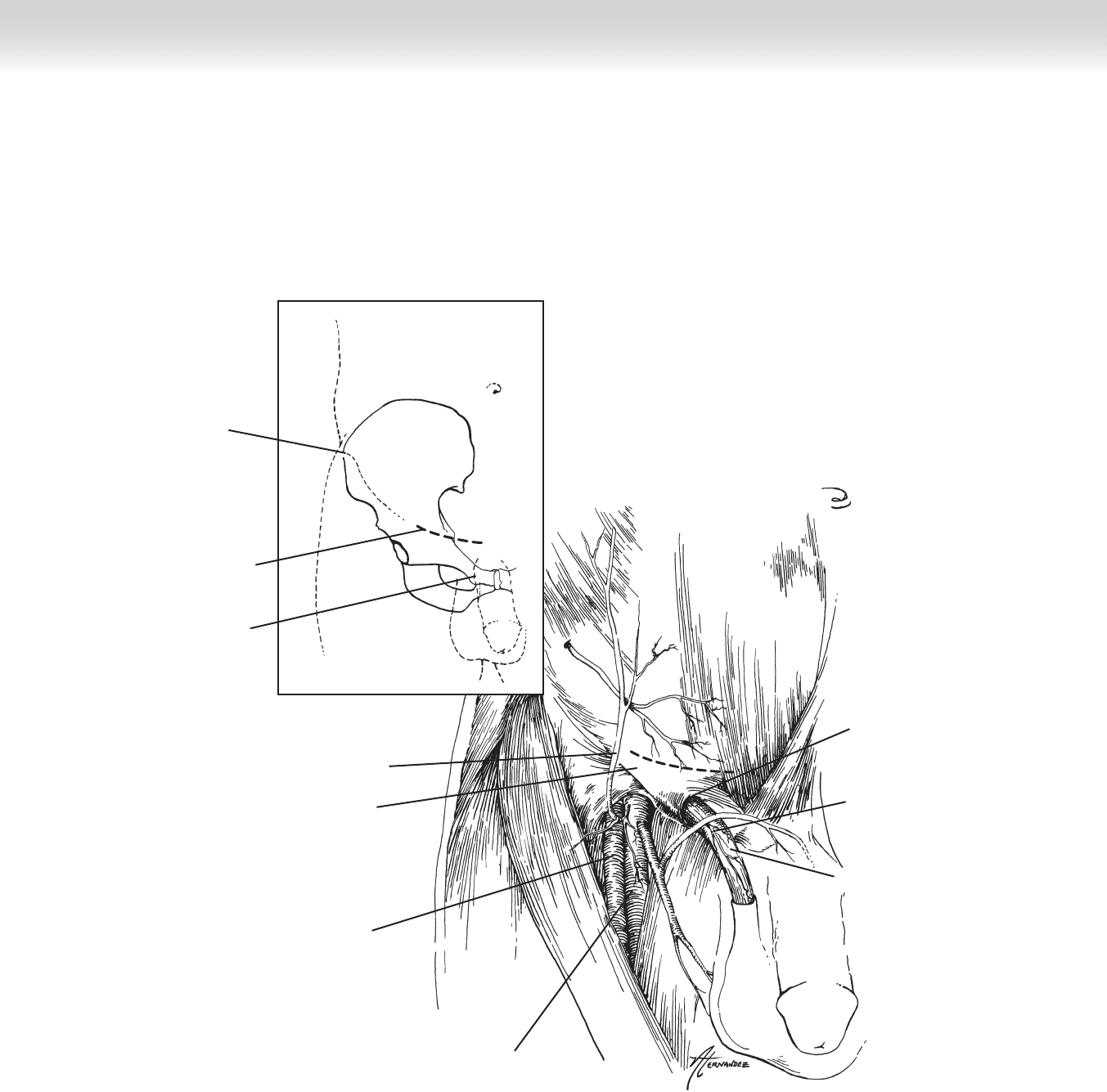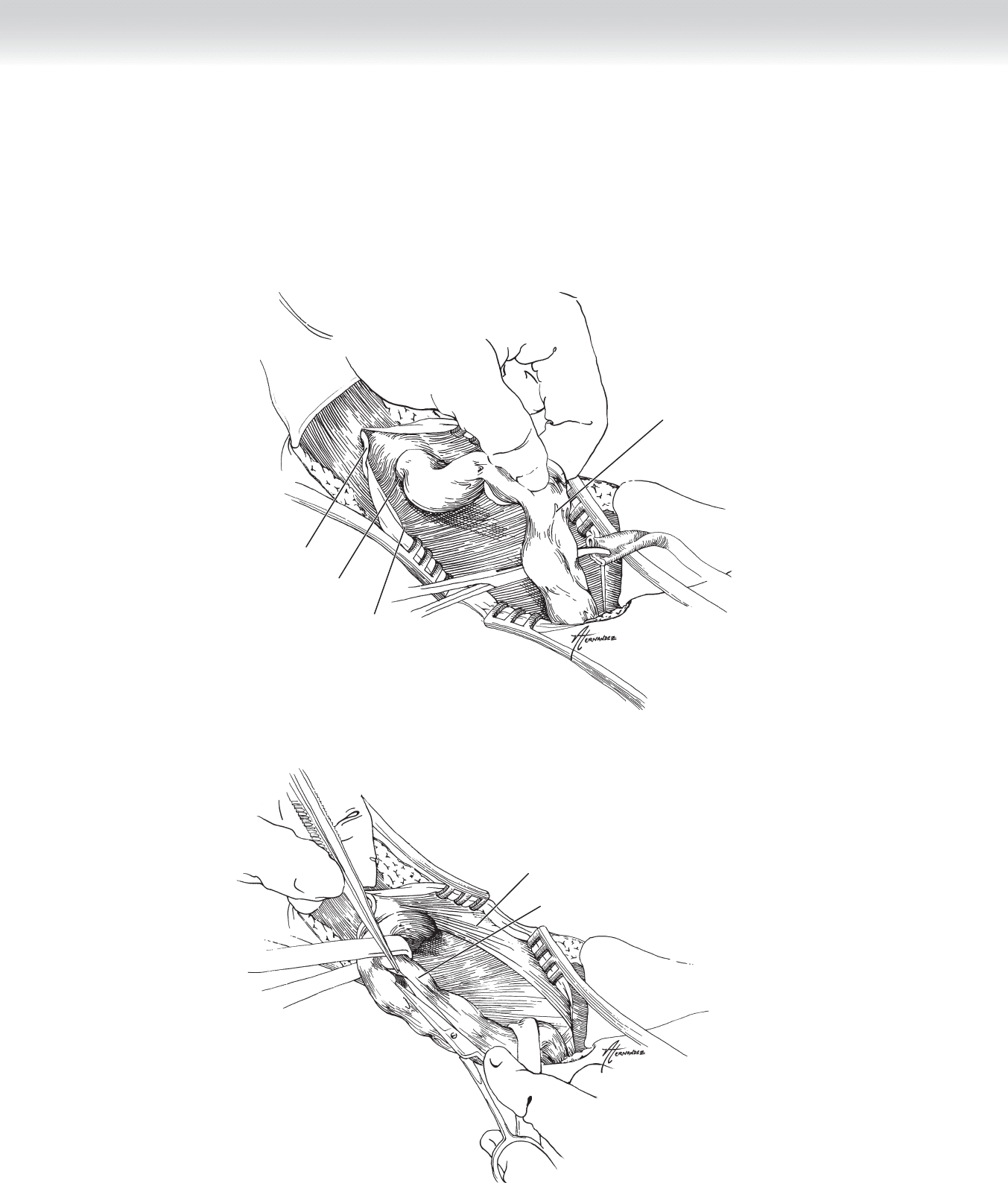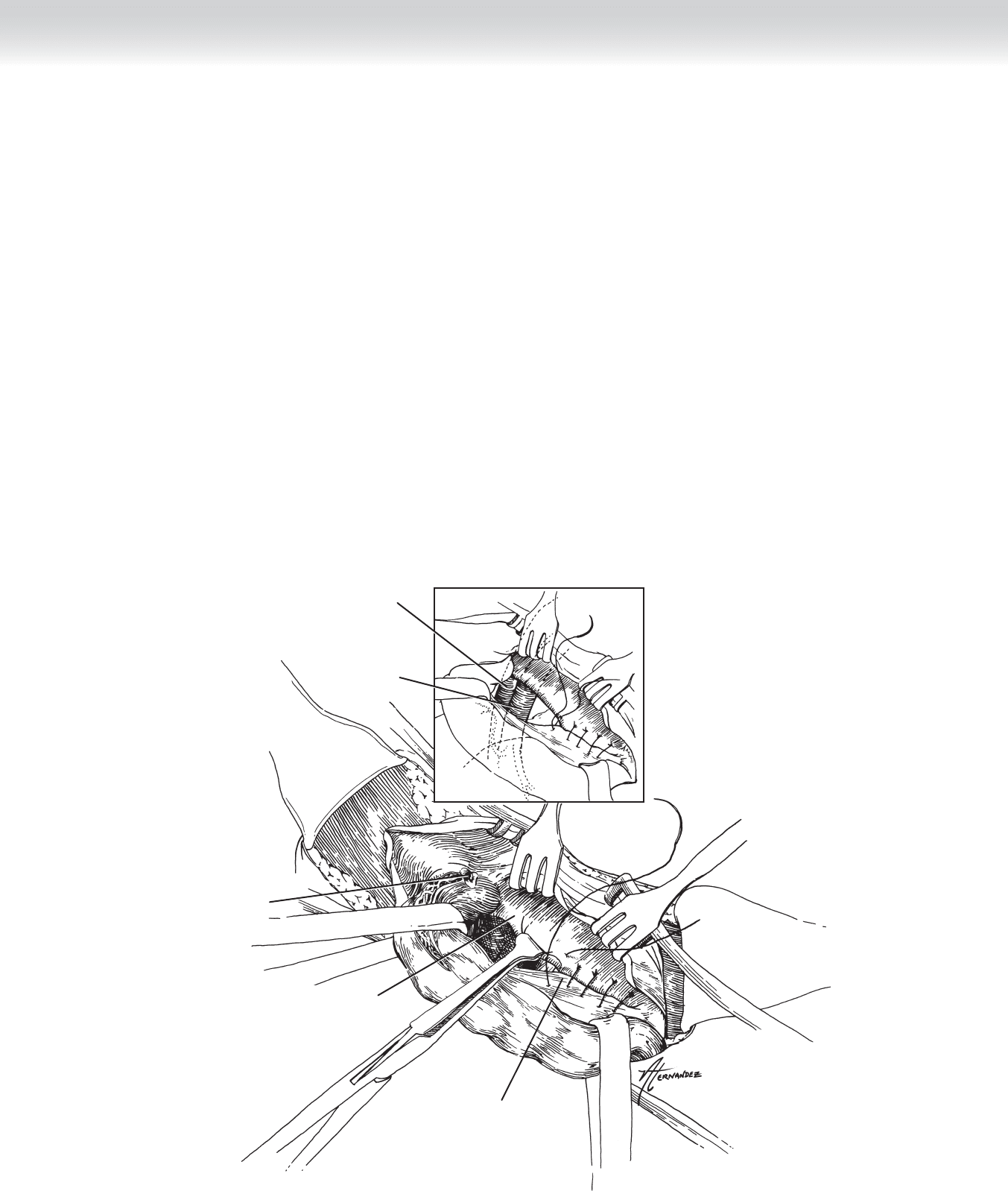Townsend Courtney M.Jr., Evers B. Mark. Atlas of General Surgical Techniques: Expert Consult
Подождите немного. Документ загружается.


CHAPTER 72 • Mesh Repair 799
Attenuated
transversalis fascia
FIGURE 72 –5
Cut edge of
transversalis fascia
2-0 Vicryl
FIGURE 72 –6

800 Section XI • Hernias
◆ Deployment and fi xation of the anterior fl ap is accomplished much the same as in repair
of an indirect hernia with two exceptions (see Figure 72-6).
◆ The notch at the internal ring is cut in the lateral inferior part of the mesh because of
the more medial placement of the connecting ring (Figure 72-7).
◆ Most surgeons are more generous with tacking sutures because of the greater propensity
for mesh extrusion early in the postoperative course.
3. CLOSING
◆ Closure is the same for either direct or indirect hernias with approximation of the external
oblique aponeurosis over the completed repair with running 2-0 or 3-0 Vicryl. Care is
taken to reconstruct the external ring.
◆ Scarpa’s fascia and the superfi cial subcutaneous fat are closed with interrupted 3-0 Vicryl
sutures to eliminate dead space and remove tension from the skin closure.
◆ The skin is closed with running subcuticular 4-0 Monocryl reinforced with Steri-Strips.
2-0 Vicryl tacking suture
Notch located in lateral
inferior portion of mesh
FIGURE 72 –7

CHAPTER 72 • Mesh Repair 801
STEP 4: POSTOPERATIVE CARE
◆ Wound care instructions are similar to those of any other abdominal operation. Patients are
told that they can begin showering in 24 to 36 hours. Steri-Strips are left on until they fall
off or need to be removed for other reasons.
◆ Patients are discharged on the day of surgery with prescriptions for oral pain medications.
◆ In general, patients are told that they may resume any and all activity in a stepwise progres-
sion as their own comfort dictates.
◆ The only exceptions are patients with large, blowout, direct hernias. In these cases, most
patients limit activity for 3 to 4 weeks to help prevent mesh extrusion.
STEP 5: PEARLS AND PITFALLS
◆ I always use the extended size in adult males, preferring to trim any unnecessary mesh from
the anterior fl ap rather than using too small a piece overall. In women, an extended or large
size generally suffi ces. I have never used the medium size in an inguinal hernia repair.
◆ The anterior fl ap of the mesh is designed so that its long axis should parallel the long axis
of the inguinal canal. Because the longitudinal orientation of the mesh is diffi cult to change
once the posterior fl ap is deployed, correct orientation is best achieved by loading the mesh
onto the sponge forceps such that the handles lie parallel to the long axis of the mesh and
the inguinal canal at insertion.
◆ If, as is often the case, it is necessary to pull the anterior fl aps out of the preperitoneal space
after insertion on the sponge forceps, it is useful to place the index fi nger of the opposing
hand in the connecting ring between the anterior and posterior fl aps of the mesh. This will
prevent accidental withdrawal of the posterior fl ap at the same time.
SELECTED REFERENCES
1. Zinner MJ, Schwartz SI, Ellis H: Hernias. In Maingot R, Zinner M (eds): Maingot’s Abdominal Operations,
vol 1, 10th ed. Stamford, Conn, Appleton & Lang, 1997, pp 479-580.
2. Condon RE: The anatomy of the inguinal region and its relation to groin hernias. In Nyhus LM,
Condon RE (eds): Hernia, 4th ed. Philadelphia, JB Lippincott, 1995, pp 16-72.

802
STEP 1: SURGICAL ANATOMY
◆ The anterior superior iliac spine and the ipsilateral pubic tubercle are identifi ed and marked
(Figure 73-1).
STEP 2: PREOPERATIVE CONSIDERATIONS
◆ To avoid any confusion about the site of surgery, the site should be marked by the operat-
ing surgeon while the patient is awake in the preoperative area.
◆ Patient is positioned supine.
◆ Anesthesia may be general, regional, or local.
STEP 3: OPERATIVE STEPS
1. INCISION
◆ A near transverse incision is then made in the skin, paralleling Langer’s lines, 1 to 2 inches
inferior and medial to the iliac spine to a point 1 to 2 inches lateral and superior to the
pubic tubercle (see Figure 73-1).
CHAPTER
73
Inguinal Herniorrhaphy—Bassini
William J. Mileski

CHAPTER 73 • Inguinal Herniorrhaphy—Bassini 803
Anterior superior
iliac spine
Pubic tubercle
Femoral artery
Femoral vein
Ilioinguinal nerve
Spermatic cord
Inguinal (Poupart’s) ligament
External
inguinal ring
Inferior epigastric artery
Incision
FIGURE 73 –1

804 Section XI • Hernias
2. DISSECTION
◆ Subcutaneous fat is dissected, and the external oblique aponeurosis, inguinal ligament, and
external inguinal ring are exposed (Figure 73-2).
◆ The external oblique is incised from the external ring to a point lateral to the internal ring.
Blunt dissection is used to separate the external oblique fascia from the underlying tissues,
and the external oblique fascia is held with a self-retaining retractor (Figure 73-3).
◆ The ilioinguinal nerve is dissected from the cord structures and cremaster and retracted to
the inferior lateral aspect of the wound.

CHAPTER 73 • Inguinal Herniorrhaphy—Bassini 805
External oblique fascia
External inguinal ring
FIGURE 73 –2
Ilioinguinal nerve
Internal oblique fascia
FIGURE 73 –3

806 Section XI • Hernias
◆ The spermatic cord is then fully encircled at the pubis and retracted with a Penrose drain
(Figures 73-4 and 73-5). Cremasteric fi bers are dissected from the cord structures, and if
present the indirect hernia sac is identifi ed; its contents are reduced; and the sac is ligated
with a nonabsorbable suture, such as 2-0 silk (Figure 73-6).
Ilioinguinal nerve
Internal
inguinal ring
Spermatic cord
External oblique
aponeurosis
External oblique aponeurosis (fascia)
Spermatic cord
FIGURE 73 –4
FIGURE 73 –5

CHAPTER 73 • Inguinal Herniorrhaphy—Bassini 807
Reduction of hernia
Purse-string suture at
neck of hernia
FIGURE 73 –6

808 Section XI • Hernias
◆ The repair of the inguinal fl oor can then be accomplished by approximating the refl ex por-
tion of the inguinal ligament to the inferior aspects of the transversalis fascia and the trans-
versus abdominis muscles. In some patients this is clearly fused as a conjoint tendon;
however most often the tissues of the transversalis and transversus abdominis are diffi cult
to distinguish. This can be aided by retracting the internal oblique muscle with a rake or
Senn retractor and grasping the transversalis fascia and transversus abdominis with several
Allis clamps. Interrupted nonabsorbable sutures (0 silk or 0 Prolene) are then placed
approximately 1 cm apart from the pubic tubercle to the internal ring. It is important to
avoid injury to the femoral vessels as the sutures are placed near the internal inguinal ring.
Two additional ligatures are placed lateral to the internal ring, leaving enough room for the
spermatic cord without causing venous obstruction (Figure 73-7).
◆ The spermatic cord and ilioinguinal nerve are replaced, and the external oblique muscle is
reapproximated using a running absorbable suture, such as 2-0 Vicryl (Figure 73-8).
3. CLOSING
◆ Skin is closed with a running subcuticular suture of 3-0 Monocryl (Figure 73-9).
Femoral artery
Femoral vein
Ligated sac
Conjoined tendon
Reflex portion of
inguinal ligament
FIGURE 73 –7
